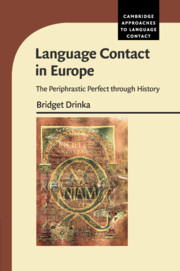Book contents
- Frontmatter
- Contents
- Series Editor's Foreword
- Acknowledgments
- Abbreviations, Based on the Leipzig Glossing Rules
- 1 Language Contact in Europe: The Periphrastic Perfect through History
- 2 Languages in Contact, Areal Linguistics, and the Perfect
- 3 The Perfect as a Category
- 4 Sources of the Perfect in Indo- European
- 5 The Periphrastic Perfect in Greek
- 6 The Periphrastic Perfect in Latin
- 7 The Charlemagne Sprachbund and the Periphrastic Perfects
- 8 The Core and Peripheral Features of the Romance Languages
- 9 The Early Development of the Perfect in the Germanic Languages
- 10 The Semantic Shift of Anterior to Preterite
- 11 The Balkan Perfects: Grammaticalization and Contact
- 12 Byzantium, Orthodoxy, and Old Church Slavonic
- 13 The l- perfect in North Slavic
- 14 Updating the Notion of Sprachbund: New Resultatives and the Circum- Baltic “Stratifi ed Convergence Zone”
- 15 The have Resultative in North Slavic and Baltic
- 16 Conclusions
- Notes
- Bibliography
- Index
7 - The Charlemagne Sprachbund and the Periphrastic Perfects
Published online by Cambridge University Press: 23 February 2017
- Frontmatter
- Contents
- Series Editor's Foreword
- Acknowledgments
- Abbreviations, Based on the Leipzig Glossing Rules
- 1 Language Contact in Europe: The Periphrastic Perfect through History
- 2 Languages in Contact, Areal Linguistics, and the Perfect
- 3 The Perfect as a Category
- 4 Sources of the Perfect in Indo- European
- 5 The Periphrastic Perfect in Greek
- 6 The Periphrastic Perfect in Latin
- 7 The Charlemagne Sprachbund and the Periphrastic Perfects
- 8 The Core and Peripheral Features of the Romance Languages
- 9 The Early Development of the Perfect in the Germanic Languages
- 10 The Semantic Shift of Anterior to Preterite
- 11 The Balkan Perfects: Grammaticalization and Contact
- 12 Byzantium, Orthodoxy, and Old Church Slavonic
- 13 The l- perfect in North Slavic
- 14 Updating the Notion of Sprachbund: New Resultatives and the Circum- Baltic “Stratifi ed Convergence Zone”
- 15 The have Resultative in North Slavic and Baltic
- 16 Conclusions
- Notes
- Bibliography
- Index
Summary
Core vs. Periphery in the Charlemagne Sprachbund
In the conclusion to his edited volume in the EUROTYP series on adverbs, Johan van der Auwera (1998b: 824) introduces the term Charlemagne Sprachbund to refer to the area of Western Europe where languages adhere to an array of similar grammatical patterns and thus provide evidence for the existence of a European linguistic area, also called Standard Average European (see Chapter 2 for discussion). Van der Auwera notes that the “core” areas of the Sprachbund are French, German, and Dutch, with Italian and Polish closely linked – all located within or near to the area ruled by Charlemagne. He demonstrates the degree of similarity that exists across European adverbial constructions by assembling a list of the features that tend to occur more frequently in the core area and less frequently in the periphery, counting the occurrence of these features, and grouping the varieties with similar numbers of features on an isopleth map (Figure 7.1) (cf. Haspelmath's similar map, presented as Figure 2.1 in subsection 2.3.1). For reference, we can examine Figure 7.2, which is an actual map of the holdings of Charlemagne at the time of his death in 814.
Van der Auwera (1998: 824) gives the following explanation for this distribution:
[I]f the convergence is not completely due to genetic relatedness, chance or some independent structural feature(s), then it must in some measure be due to language contact, either in a direct way, to language interference between coterritorial or adjacent languages, or in an indirect way, to the fact that some languages have been excluded from contact-instigated change.
He thus points to the essential role of both centrality and peripherality as explanatory principles of innovation through contact, since the profile of groups who did not adopt a change can be as telling as information about those who do.
Van der Auwera goes on to present a similar mapping of temporal-aspectual features of the languages of Europe, based on Thieroff (2000: 265–305), which also points to French and German as core members of the Sprachbund (Figure 7.3).
The features that van der Auwera (1998: 833 n13) utilizes from Theiroff (2000) in order to construct this map are shown in Table 7.1
- Type
- Chapter
- Information
- Language Contact in EuropeThe Periphrastic Perfect through History, pp. 144 - 168Publisher: Cambridge University PressPrint publication year: 2017



